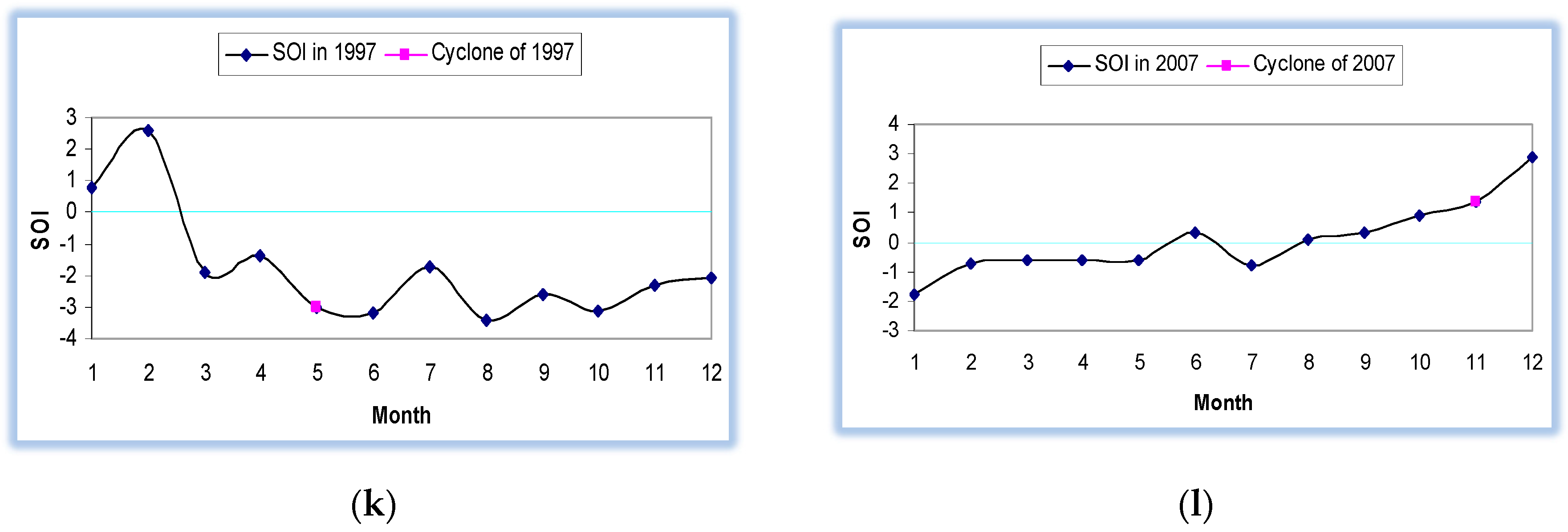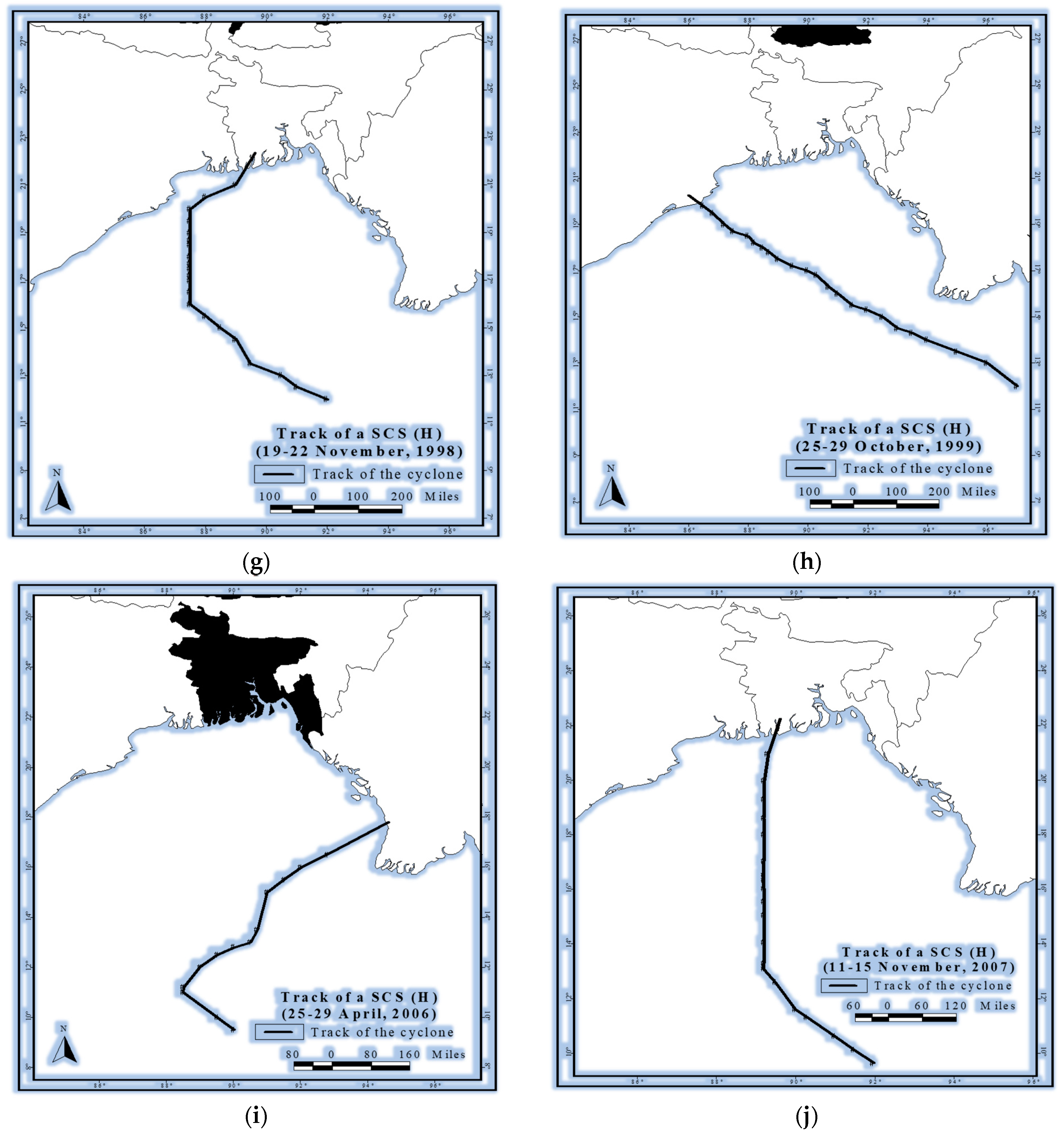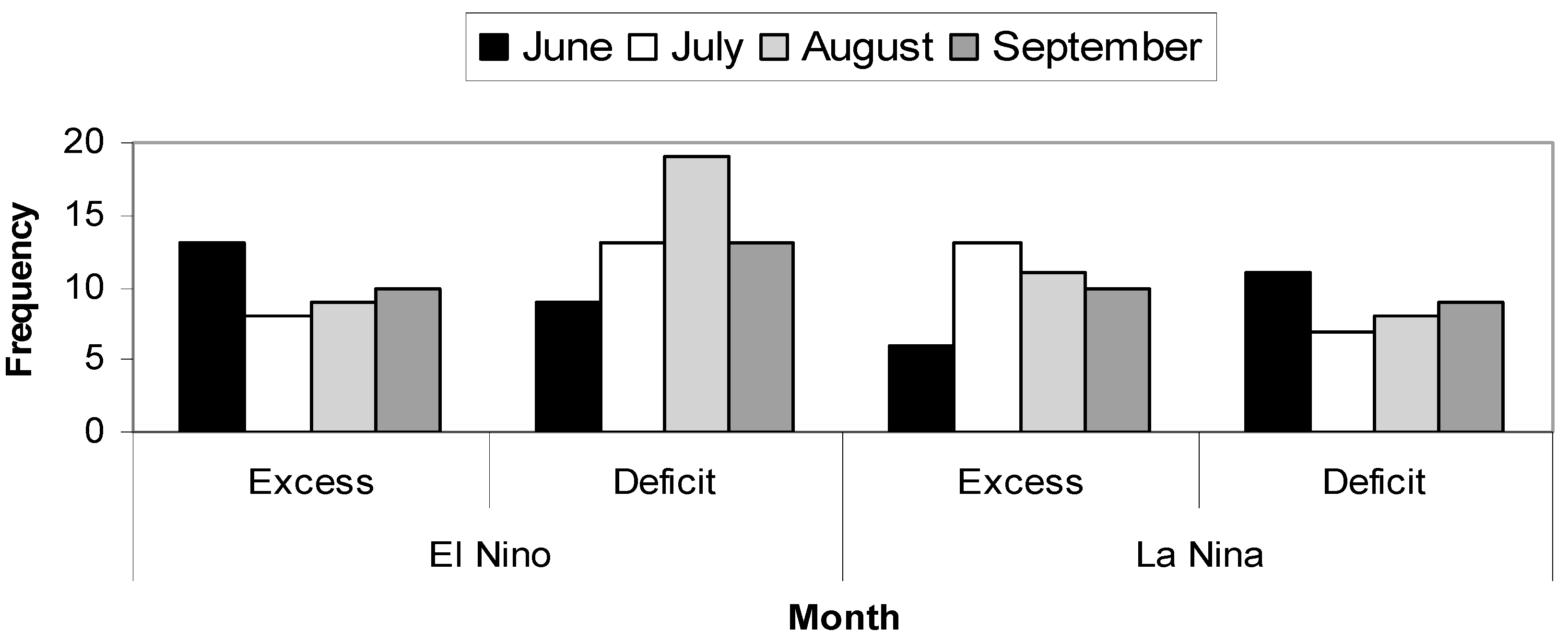Major Floods and Tropical Cyclones over Bangladesh: Clustering from ENSO Timescales
Abstract
1. Introduction
2. Data and Methods
3. Results
3.1. Categorizing of Major Floods on ENSO Timescales
3.2. Categorizing of Major TCs on ENSO Timescales
3.3. Mechanisms
4. Conclusions
Funding
Institutional Review Board Statement
Informed Consent Statement
Data Availability Statement
Conflicts of Interest
References
- Ali, A. Vulnerability of Bangladesh to climate change and sea level rise through tropical cyclones and storm surges. Water Air Soil Pollut. 1996, 92, 171–179. [Google Scholar]
- Ali, A. Climate change impacts and adaptation assessment in Bangladesh. Clim. Res. 1999, 12, 109–116. [Google Scholar] [CrossRef]
- Ali, A. Cyclone; Bangla Academy: Dhaka, Bangladesh, 1999; p. 147. [Google Scholar]
- Zebiak, S.E.; Cane, M.A.A. Model El Niño–Southern Oscillation. Mon. Weather Rev. 1987, 115, 2262–2278. [Google Scholar] [CrossRef]
- Wallace, J.M. El Niño and Climate Prediction; Washington University Press: Washington, DC, USA, 1994; Volume 3, p. 142. [Google Scholar]
- Wang, H.J.; Zhang, R.H.; Cole, J.; Chavez, F. El Niño and the related phenomenon Southern Oscillation (ENSO), The largest signal in interannual climatic variation. Proc. Natl. Acad. Sci. USA 1999, 96, 11071–11072. [Google Scholar] [CrossRef]
- Pastor, R. El Niño Climate Pattern Forms in Pacific Ocean; USA Today: McLean, VA, USA, 2006. [Google Scholar]
- Miah, M.M. Flood in Bangladesh; Academic Publishers: Dhaka, Bangladesh, 1988. [Google Scholar]
- Islam, A.R.M.T.; Talukdar, S.; Mahato, S.; Kundu, S.; Eibek, K.U.; Pham, Q.B.; Kuruki, A.; Linh, N.T.T. Flood susceptibility modelling using advanced ensemble machine learning models. Geosci. Front. 2021, 12, 101075. [Google Scholar] [CrossRef]
- Brammer, H. Floods in Bangladesh: Geographical background to the 1987 and 1988 floods. Geogr. J. 1990, 156, 12–22. [Google Scholar] [CrossRef]
- Mohapatra, M.; Bandyopadhyay, B.K.; Tyagi, A. Best track parameters of tropical cyclones over the North Indian Ocean: A review. Nat. Hazards 2012, 63, 1285–1317. [Google Scholar] [CrossRef]
- Singh, O.P.; Ali-Khan, T.M.; Rahman, M.S. Changes in the frequency of tropical cyclones over the North Indian Ocean. Meteorol. Atmos. Phys. 2000, 75, 11. [Google Scholar] [CrossRef]
- Wahiduzzaman, M.; Yeasmin, A. Statistical forecasting of tropical cyclone landfall activities over the North Indian Ocean rim. Atmos. Res. 2019, 227, 89–100. [Google Scholar] [CrossRef]
- Wahiduzzaman, M.; Oliver, E.C.J.; Wotherspoon, S.J.; Holbrook, N.J. A climatological model of North Indian Ocean tropical cyclone genesis, tracks and landfall. Clim. Dyn. 2017, 49, 2585–2603. [Google Scholar] [CrossRef]
- Balaguru, K.; Taraphdar, S.; Leung, L.R.; Foltz, G.R. Increase in the intensity of postmonsoon Bay of Bengal tropical cyclones. Geophys. Res. Lett. 2014, 41, 3594–3601. [Google Scholar] [CrossRef]
- Sahoo, B.; Bhaskaran, P.K. Assessment on historical cyclone tracks in the Bay of Bengal, east coast of India. Int. J. Clim. 2016, 36, 95–109. [Google Scholar] [CrossRef]
- Wahiduzzaman, M.; Oliver, E.C.J.; Klotzbach, P.J.; Wotherspoon, S.J.; Holbrook, N.J. A statistical seasonal forecast model of North Indian Ocean tropical cyclones using the Quasi-biennial Oscillation. Int. J. Clim. 2019, 39, 934–952. [Google Scholar] [CrossRef]
- Wahiduzzaman, M.; Yeasmin, A. A kernel density estimation approach of North Indian Ocean tropical cyclone formation and the association with convective available potential energy and equivalent potential temperature. Meteorol. Atmos. Phys. 2020, 132, 603–612. [Google Scholar] [CrossRef]
- Girishkumar, M.S.; Ravichandran, M. The influences of ENSO on tropical cyclone activity in the Bay of Bengal during October-December. J. Geophys. Res. Ocean. 2012, 117. [Google Scholar] [CrossRef]
- Wahiduzzaman, M.; Oliver, E.; Wotherspoon, S.; Luo, J.J. Statistical forecasting of tropical cyclones over the North Indian Ocean and the role of El Niño-Southern Oscillation. Clim. Dyn. 2020, 54, 1571–1589. [Google Scholar] [CrossRef]
- Girishkumar, M.S.; Suprit, K.; Vishnu, S.; Prakash, V.P.T.; Ravichandran, M. The role of ENSO and MJO on rapid intensification of tropical cyclones in the Bay of Bengal during October–December. Theor. Appl. Climatol. 2015, 120, 797–810. [Google Scholar] [CrossRef]
- Felton, C.S.; Subrahmanyam, B.; Murty, V.S.N. ENSO-modulated cyclogenesis over the Bay of Bengal. J. Clim. 2013, 26, 9806–9818. [Google Scholar] [CrossRef]
- Choudhury, A.M. Bangladesh Floods, Cyclones & the ENSO. In Proceedings of the International Monsoon Conference, Trieste, Italy, 9–13 May 1994; WCRP-84 and WMO/TD-No. 619. WMO: Geneva, Italy, 1994. [Google Scholar]
- Singh, O.P.; Khan, T.M.A.; Rahman, S. Probable reasons for enhanced cyclogenesis in the Bay of Bengal during July–August of ENSO years. Glob. Planet. Chang. 2001, 29, 135–147. [Google Scholar] [CrossRef]
- Mandal, G.S. Low Frequency Oscillation and Seasonal Variability of Tropical Cyclones; Topics Chairman and Rapporteur’s Report of the Second WMO Workshop on Tropical Cyclones (IWTC-II); WMO/TD No. 319; World Meteorological Organization: Geneva, Switzerland, 1989. [Google Scholar]
- Mandal, G.S. Low Frequency Oscillation and Seasonal Variability of Tropical Cyclones of North Indian Ocean. Ph.D. Thesis, Jadavpur University, Kolkata, India, 1990; pp. 406–444. [Google Scholar]
- Girishkumar, M.S.; Thanga Prakash, V.P.; Ravichandran, M. Influence of Pacific Decadal Oscillation on the relationship between ENSO and tropical cyclone activity in the Bay of Bengal during October–December. Clim. Dyn. 2014, 44, 3469–3479. [Google Scholar] [CrossRef]
- Wahiduzzaman, M.; Yeasmin, A.; Luo, J.J. Seasonal movement prediction of tropical cyclone over the North Indian Ocean by using atmospheric climate variables. Atmos. Res. 2020, 245, 105089. [Google Scholar] [CrossRef]
- Wahiduzzaman, M.; Yeasmin, A.; Luo, J.J.; Quadir, D.A.; Amstel, A.V.; Cheung, K.W.; Yuan, C. Markov Chain Monte Carlo simulation and regression approach guided by El Niño-Southern Oscillation to model the tropical cyclone occurrence over the Bay of Bengal. Clim. Dyn. 2021, 5, 1–12. [Google Scholar]
- Wahiduzzaman, M.; Luo, J.J. A statistical analysis on the contribution of El Niño-Southern Oscillation to the rainfall and temperature over Bangladesh. Meteorol. Appl. Phys. 2021, 133, 55–68. [Google Scholar] [CrossRef]











| Phase of ENSO | Years |
|---|---|
| El Niño | 1958, 1966, 1973, 1978, 1980, 1983, 1987, 1988, 1992, 1995, 1998 2003, 2007, 2010, 2014 |
| La Niña | 1950, 1951, 1955, 1956, 1962, 1971, 1974, 1976, 1989, 1999, 2000 2008, 2011, 2012 |
| Neutral | 1948–1949, 1952–1954, 1957, 1959–1961, 1963–1965, 1967–1970, 1972, 1975, 1977, 1979, 1981–1982, 1984–1986, 1990–1991, 1993–1994, 1996–1997, 2001–2002, 2004–2006, 2009, 2013–2014, 2015–2016. |
| Year | Flood Affected Area (Sq km) | Affected Area (%) | SOI | Phase of ENSO |
|---|---|---|---|---|
| 1955 | 50,700 | 34.2 | 2.4 | La Niña |
| 1974 | 52,720 | 36.6 | 1.4 | La Niña |
| 1987 | 57,491 | 39.9 | −2.2 | El Niño |
| 1988 | 89,970 | 63 | 2.8 | La Niña |
| 1998 | 100,250 | 68 | 1.9 | La Niña |
| 2004 | 55,000 | 38 | −1.2 | El Niño |
| 2007 | 62,289 | 42.2 | 0.1 | Neutral |
| Year | Month | Crossing Area | SOI | Phase of ENSO |
|---|---|---|---|---|
| 1960 | 30–31 October | North Part of Chittagong | 0.8 | La Niña |
| 1961 | 5–9 May | Meghna Estuary | 0.2 | Neutral |
| 1963 | 28 May | North Part of Chittagong | 0.2 | Neutral |
| 1965 | 7–15 December | Cox’s Bazar | 0 | Neutral |
| 1970 | 13 November | North Part of Chittagong | 2.8 | La Niña |
| 1974 | 24–28 November | Chittagong | −0.5 | Neutral |
| 1985 | 22–25 May | Chittagong | 0.3 | Neutral |
| 1988 | 24–30 November | Khulna | 3 | La Niña |
| 1991 | 25–30 April | North Part of Chittagong | −2 | El Niño |
| 1994 | 24 April–2 May | Teknaf | −1.7 | El Niño |
| 1997 | 15–19 May | Teknaf | −3 | El Niño |
| 2007 | 11–15 November | Khulna Barisal | 1.4 | La Niña |
| Cyclone | Month | SOI | ENSO Phase | Point of Formation (N) | Lat. of Re-Curvature (N) | Point of Landfall (N) |
|---|---|---|---|---|---|---|
| 1981 | December | 0.7 | La Niña | 11° | 12°–16° | 21.2° |
| 1988 | November | 3 | La Niña | 10° | 14° | 20.5° |
| 1991 | April | −2 | El Niño | 11.5° | 16° | 22.3° |
| 1992 | November | −1.4 | El Niño | 9.5° | 16° | 21° |
| 1995 | November | −0.1 | El Niño | 7.5° | 14° | 20° |
| 1997 | May | −3 | El Niño | 7.5° | 19° | 21.8° |
| 1998 | November | 1.7 | La Niña | 12° | 16° | 21° |
| 1999 | October | 1.5 | La Niña | 12° | Straight | 19.8° |
| 2006 | April | 1.5 | La Niña | 9.5° | 12° | 16.5° |
| 2007 | November | 1.4 | La Niña | 9.5° | 12° | 21° |
Publisher’s Note: MDPI stays neutral with regard to jurisdictional claims in published maps and institutional affiliations. |
© 2021 by the author. Licensee MDPI, Basel, Switzerland. This article is an open access article distributed under the terms and conditions of the Creative Commons Attribution (CC BY) license (https://creativecommons.org/licenses/by/4.0/).
Share and Cite
Wahiduzzaman, M. Major Floods and Tropical Cyclones over Bangladesh: Clustering from ENSO Timescales. Atmosphere 2021, 12, 692. https://doi.org/10.3390/atmos12060692
Wahiduzzaman M. Major Floods and Tropical Cyclones over Bangladesh: Clustering from ENSO Timescales. Atmosphere. 2021; 12(6):692. https://doi.org/10.3390/atmos12060692
Chicago/Turabian StyleWahiduzzaman, Md. 2021. "Major Floods and Tropical Cyclones over Bangladesh: Clustering from ENSO Timescales" Atmosphere 12, no. 6: 692. https://doi.org/10.3390/atmos12060692
APA StyleWahiduzzaman, M. (2021). Major Floods and Tropical Cyclones over Bangladesh: Clustering from ENSO Timescales. Atmosphere, 12(6), 692. https://doi.org/10.3390/atmos12060692






